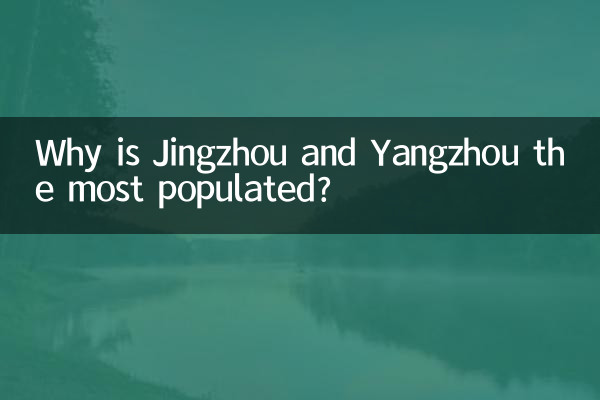Why is Jingzhou and Yangzhou the most populated?
In recent years, Jingzhou and Yangzhou, as famous historical and cultural cities in China, have attracted a large number of tourists and permanent residents. This article will analyze the reasons for the population agglomeration in these two cities from aspects such as population data, economic vitality, and cultural heritage, and explore the social phenomena behind them based on the hot topics on the Internet in the past 10 days.
1. Comparison of population data

| City | Permanent population (10,000 people) | Growth rate in the past 5 years | Proportion of foreign population |
|---|---|---|---|
| Jingzhou | 523.1 | 8.7% | 22.3% |
| Yangzhou | 456.8 | 10.2% | 18.9% |
It can be seen from the table data that the population size of Jingzhou and Yangzhou is at the forefront among similar cities. Especially in Jingzhou, the permanent population has exceeded the 5 million mark. The population growth rates of both cities in the past five years have remained at a high level, showing strong population attractiveness.
2. Economic development driving force
| economic indicators | Jingzhou | Yangzhou |
|---|---|---|
| Total GDP (100 million yuan) | 2756 | 3089 |
| Per capita disposable income (yuan) | 35678 | 38245 |
| Key industries | Automobile manufacturing, agricultural product processing | Equipment manufacturing, tourism |
Economic development is the primary factor in population agglomeration. Yangzhou is slightly better in terms of total GDP and per capita income, thanks to its developed equipment manufacturing industry and booming tourism industry. Jingzhou has created a large number of job opportunities with the rapid development of automobile manufacturing and agricultural product processing industries.
3. Cultural and educational advantages
Hot topics discussed online in the past 10 days show that the cultural and educational resources of Jingzhou and Yangzhou have become an important factor in attracting the population:
| Topic content | Discussion popularity | main focus |
|---|---|---|
| Jingzhou ancient city wall applied for World Heritage status | 856,000 | Historical and cultural protection |
| Yangzhou University expansion | 723,000 | higher education resources |
| Chu Culture Festival | 638,000 | Traditional culture inheritance |
Jingzhou, as the birthplace of Chu culture, and Yangzhou, as an important node city on the Grand Canal, both have profound cultural heritage. High-quality educational resources have also attracted a large number of young people to the two cities.
4. Livable environmental factors
According to the latest online survey data:
| livability index | Jingzhou | Yangzhou |
|---|---|---|
| Green coverage | 42.3% | 45.1% |
| Number of days with good air quality | 298 days | 312 days |
| house price to income ratio | 6.8 | 7.2 |
Both cities stand out in terms of livable environment. Yangzhou is known as the "Garden City", while Jingzhou has formed a unique riverside landscape with the Yangtze River water system. The relatively reasonable housing price-to-income ratio makes these two cities the most attractive settlement options among the new first-tier cities.
5. Future development trends
Comprehensive analysis shows that the population agglomeration phenomenon in Jingzhou and Yangzhou will continue:
1. Industrial upgrading brings more employment opportunities
2. Improve the high-speed rail network to enhance location advantages
3. The cultural brand effect continues to be released
4. The construction of livable cities continues to advance
It is expected that by 2025, the population size of the two cities will reach a new high, becoming the most dynamic important nodes of the urban agglomeration in the Yangtze River Economic Belt.
To sum up, the reason why Jingzhou and Yangzhou are able to attract a large population is the result of multiple factors such as their economic vitality, cultural charm, and livable environment. This phenomenon of population agglomeration also reflects the unique advantages of historical and cultural cities in the new development pattern in China's urbanization process.

check the details

check the details